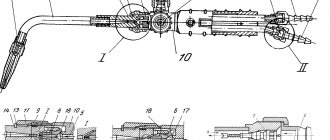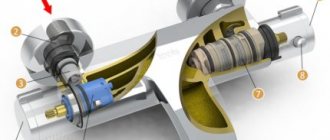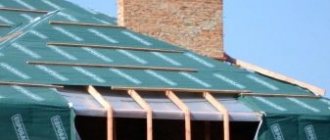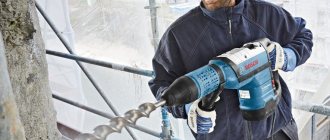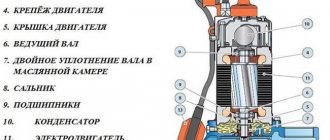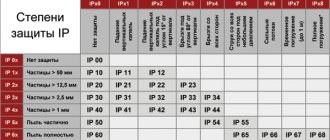How to make a gas burner with your own hands: stages of making the device
Almost no machining is required to assemble the tool. The gas burner is assembled from ready-made elements. To do this you need to prepare:
- propane reducer for gas cylinder;
- plug, which is used for transporting gas containers;
- nozzle from a blowtorch - nozzle diameter is 0.8 mm;
- part of a pipe having the following dimensions: length - 1 meter, diameter - 1 cm, steel thickness - 2 mm;
- wooden handle (suitable from an old non-working soldering iron).
The process of making a gas burner with your own hands is not particularly difficult.
First of all, you need to insert the steel supply tube into the handle and secure it with glue. The divider and the body of the structure are made of brass rod with a diameter of 20 mm. In the finished body, you need to drill two radial holes (5 mm each) and four holes with a diameter of 1 mm in the divider rod.
Before you make a burner with your own hands, you need to study its components
It is necessary to press the divider into the body with a slight tension. The inner diameter of the body should be 0.6 mm larger than the diameter of the grooves. The resulting gap is intended to slow down the flow of gas, which is supplied to the holes in the igniter.
Next you need to make a nozzle. Since the hole is very thin, you will need a drill with a diameter of 2 mm to drill it. With its help, a blind hole is created at a distance of 1.5 mm from the exit. Using a drill with a diameter of 0.4 mm, a jumper is made.
The resulting hole should be completely caulked; to do this, you will need to lightly hit it with a hammer several times. Use sanding paper to sharpen the end until the nozzle can be placed on the tip of the burner tube.
A supply fabric-rubber hose must be put on the end of the gas supply tube. It should be secured with a clamp. Then the operating pressure is set and gas is supplied. Before setting fire, you need to wait until the air comes out of the nozzle.
The process of making a gas burner with your own hands is not particularly difficult.
The length of the burner flame should be 5 cm. The body together with the divider is placed on the external thread of the nozzle
It is important to ensure that the flame of the gas burner with your own hands is even and without soot
Roofing repair work necessarily requires the use of hot air or even an open flame. Melt bitumen, melt a roll of roofing material or perform metal soldering - a gas roof burner will do an excellent job with these tasks. To perform a significant amount of work, you need to buy a reliable professional model, but for home use you can create the design yourself.
Base surface requirements
From the surface on which the fused roofing is to be installed, it is necessary to remove:
- potholes and sinks;
- concrete flows;
- irregularities with sharp edges;
- cracks;
- protruding fragments of reinforcement;
- oil and cement laitance stains;
- dust.
Sharp corners of structures, ends of reinforcement, concrete overhangs are cut down and cleaned. Oil stains should be burned off. The laitance film is removed by wet or dry jet-abrasive cleaning. Dust is removed using:
- brushes;
- industrial vacuum cleaner;
- blowing off with a compressor;
- rinsing with water.
Large potholes, cracks and sinkholes are sealed using cement-sand mortar M 150. Small cracks and potholes can be filled with heated bitumen mastic.
The weld coating requires a smooth and even base. Checking the evenness is carried out with a two-meter rod. The presence of smoothly increasing irregularities with a height of no more than 5 mm along the slope and 10 mm across is acceptable. The number of such irregularities should not exceed two per 4 m2 of the total base area.
When arranging a screed under a built-up coating, it is necessary to provide temperature-shrinkable joints 5 mm wide, which should not be located above the joints of load-bearing concrete slabs and the joints of monolithic thermal insulation.
Main characteristics
The capabilities of this tool should be assessed by two parameters - the diameter of the glass and the length of the feed head. The width of the flame that the device can form depends on the first criterion. Accordingly, an abundant flame will bring the work area to the desired state in a shorter period. On average, this figure varies from 50 to 80 mm. As for the length of the device, it will determine the ease of use of the burner in specific conditions. So, for cosmetic repairs of the roof covering, a roofing torch about 50 cm long is quite suitable. This option will effectively cope with local melting or heating, without causing unnecessary hassle in handling the structure. But in large-scale work on laying roll waterproofing, for example, it is desirable to use models that direct active energy over large areas. In this context, we can talk about models with a length from 80 to 100 cm.
Propane consumption per 1 m2 of waterproofing
Everything sooner or later falls into disrepair. Time passes, the integrity of the roofs is compromised, stains form on the ceilings, and the plaster crumbles. Your once expensive renovation is suffering, and it doesn’t matter what you have on the ceiling: lime, tensile structure or sheets of plasterboard. Everything deteriorates to a greater or lesser extent, especially the residents of the top floors of high-rise buildings face this fact. To repair the roof, modern waterproofing is now used, instead of the usual roofing felt. They are presented in roll materials that are joined when melted. The TechnoNIKOL company presents several types of glass insulation or hydroisol. They differ in both the base (canvas and fabric) and the method of coating (film or sprinkling). You have the opportunity to choose waterproofing that suits you in terms of technical characteristics and price.
What kind of equipment is this?
The structure of the burner includes an owner with gas supply regulators. what makes a railway with a mixer at the end. The microburner is connected with a rubber sleeve to the hydrocarbon-slide gas cylinder using a pressure regulator.
Basically, tamed gas games are used to heat the surface and fuse various substances. Gas games come in two types: forced and non-forced atmosphere.
These types of burners have the following characteristic industrial properties:
- The supply of atmosphere in a gas burner with forced supply is carried out in the following way, the air is supplied with the support of a propeller or compressor. The advantage of this type of game is the possibility of a clear torch option. The downside is the difficulty of installing the device.
- In burners that do not have a forced supply of atmosphere. air is supplied freely through a hole in the diffuser depending on the gas supply. The simple structure makes it possible to do it yourself. The disadvantages include the inadmissibility of a clear torch option.
- The gas microburner is started by igniting a gas stream. what comes out of the diffuser, some modifications take into account auto-ignition.
Variety of burners by ignition type
The simplest method of ignition is considered to be with a wick - with a burning igniter. When the automation is triggered, the gas is ignited with a wick, after which the device begins to heat the liquid. There are two negative aspects to this - increased fuel consumption and an insufficient degree of safety, since the igniter may go out. Primary ignition is performed with matches or using a piezoelectric element.
The first method is used in non-volatile devices - they do not have electronics, and the second option is when automatic gas burners are used for heating boilers. In this case, in addition to electronics, flame ionization control modules are installed on board.
Different types of fuel can be used to ignite the burner. The natural gas supplied from the main line is purer; it is supplied at optimal pressure, so the flame in the device does not smoke. Such boilers are connected to the network without making any modifications.
There are burners on sale that can operate on propane. This will require reconfiguring the system and installing the nozzle. When burned, the flame gives off a yellow glow, and there is an increased deposition of soot on the walls of the chimney. The jets normalize the propane pressure to a normal value; they are supplied as a kit or purchased.
Types of devices and characteristics
Roofing work involves the use of various types of burners. GG-2. Self-taught craftsmen who decide to carry out repair work with their own hands should start with this model. High level of quality and reasonable price. GG-2U. The parameters are the same, but in this sample the gas supply tube is much shorter. This type of tool is ideal for working in hard-to-reach areas of roofing and for gluing joints. GG-2S. A line of tools for the professional. The model uses propane to operate. The main positive quality is the ability to operate the device even in strong winds. The device has two valves and two housings, which allows adjustment of operating modes with maximum accuracy. GGS1-1.7. The model stands out for its light weight, small dimensions and high level of performance. Such parameters provide the equipment with a universal character. The main purpose is the production of roof drying and fusing of soft roofing materials. Ideal for waterproofing and other types of work that require a high-intensity flame in order to achieve a surface temperature of 400°C. GGK-1. A sample with a more massive and strong glass. This burner is mostly suitable for burning old paint, wood, and for waterproofing. Gas is supplied by pressing the lever. GGS1-1.0. It is used if it is necessary to carry out minor work in small volumes or to arrange junctions. Excellent for working on roofs with a large angular amplitude of inclination. There is also work on laying waterproofing. GGS1-0.5. Small roof repair work. The model is capable of economical fuel consumption. GGS4-1.0. The model is equipped with 4 expander cylinders, which can simultaneously heat the roof over the entire width and roll out the roll without stopping. Special hooks along the edges of the tool allow only one person to warm up and roll out the roofing material. The use of this model significantly increases the productivity of work and reduces fuel costs. GV-3. A propane torch can heat metals, weld them and solder them. The glass is 5 cm in diameter. GV-111R. Using such a device, you can melt bitumen in the form of rolls and burn old paint. GV-550, GV-900. The tools are quite comfortable to use. The only difference is the flame length, which is indicated directly in the name of the sample. The second model can be used perfectly while standing at full height. The first is better for roof junctions.
Announcements on NN.RU - Construction
Smarty owlets chest of drawers ?dimensions: w720*d466*h750 ?material: made of white chipboard + photo printing ?ball guides - full. Price: 3,690 rub.
I am selling a pipe 630x9 p/w of excellent quality. Available in warehouse in Bogorodsk, Nizhny Novgorod region. Price 40000-42000 including VAT.
Double door wardrobe Smarty Owls ?Dimensions: w700*d450*h2030 ?Material: made of white laminated chipboard + photo printing ?Filling: rod. Price: 5,490 rub.
Solid white silicate brick - for rough masonry. 691 pcs per pallet. Delivery by manipulator throughout the Nizhny Novgorod region. Price: 8 rub.
Roof burner models
To carry out roofing work, burners of different models are used.
GG-2 is the name of the propane roof burner model. The most suitable sample for self-taught craftsmen who carry out repairs with their own hands. Despite its high quality, it has a fairly reasonable price.
GG-2U has similar characteristics. A distinctive feature of this model is a shortened version of the gas supply tube. It is ideal for carrying out work in hard-to-reach parts of the roof, as well as for gluing abutments and joints.
GG-2S belongs to a series of professional equipment. This model runs on propane. Its main advantage is that the device can be operated even in strong winds. The device consists of two valves and two housings, and this makes it possible to regulate operating modes with great accuracy.
GGS1-1.7 – low weight, size and high degree of performance make this model almost universal. It is used to dry the roof and fuse soft roofing materials onto it. It is also successfully used in waterproofing and some other types of work that require a high-intensity flame to bring the surface temperature to 400 degrees.
GGK-1 – propane-air model. Its difference is a heavier and very durable glass.
This model is suitable for burning old paint, wooden surfaces, and for waterproofing work. Gas is supplied using a lever.
GGS1-1.0 is used for small works of small volumes, arrangement of junctions. Suitable for use on roofs with large slope angles. Also suitable for laying waterproofing.
GGS1-0.5 is used for minor repair work on the roof. It features economical fuel consumption.
The GGS4-1.0 model is equipped with four sockets, which allow simultaneous heating of the roofing material over the entire width and non-stop rolling of the roll.
Thanks to the presence of special hooks on the edges of the device, heating and rolling out the roofing material can be carried out by one person. Using this model, you can significantly increase the productivity of work performed and reduce fuel consumption.
GV-3 is a propane torch designed for heating metals, welding them, as well as manual soldering. The diameter of the glass is 50 mm.
GV-111R is used for melting rolled bitumen materials and burning a layer of old paint.
GV-550, GV-900 are very convenient to use samples. They differ from one another in the maximum flame length. The second model makes it possible to work standing, at full height, since the length of its torch reaches 900 mm. The first model (GV-550) is more suitable for carrying out work at roof junction points.
The GV model is suitable for heating non-ferrous and ferrous metals, melting rolled bitumen materials when carrying out waterproofing and roofing work, as well as a number of other works that require the use of exclusively propane flame.
GV 500 is used for welding work during the laying of roofing materials. It can be used to melt bituminous materials. This model can heat the processed material up to 300 degrees.
GV-850 is a propane burner equipped with a special valve that makes it possible to precisely regulate the amount of technical gas supplied from the cylinder. The model also has a lever with which the welder controls the length of the flame. This type of gas burner does not operate on pure propane, but on a mixture, part of which is technical oxygen.
Introduction
A gas burner for roofing work is the main and only assistant that is able to create the necessary conditions for high-quality installation of the roof. Due to its unique characteristics, the tool is considered irreplaceable, which increases the complexity of choice.
And everything is aggravated by the huge variety of models that are suitable for certain materials and conditions. In order for installation or repair to go smoothly, and the result to meet expectations, it is worth paying attention to the types, their features and differences.
Roof burner models
For work related to laying the roof, a specified type of device with the following modifications is used:
- GG-2 propane microburner for the purpose of preparing and performing waterproofing work. Excellent for small-scale roofing work. Recommended for use by young professionals. Mostly low price.
- The GG-2U is similar to the previous modification and is distinguished by its thick gas pipeline. It is mainly used in inaccessible areas near the roof.
- GG-2S seems to be a high-quality burner, and in addition it operates in propane. Contains 2 valves for the purpose of clearly regulating the order of operation and the likelihood of operation in very windy weather.
- GS1-1.7 contains small mass, and the volume appears to be multi-purpose. It is used for the purpose of drying and fusing substances into the roof. Makes it possible to heat the plane up to four hundred degrees.
- GK-1 air-propane microburner is armed with a depressing cup and a gas supply lever. It is used for the purpose of removing color by burning in wood surfaces and waterproofing roofs.
- GS1-1.0 contains a simple mass and small volumes, which makes it possible to use it for waterproofing roofs with a huge slope.
- GGS1-0.5 is mainly used for the purpose of small roof repairs and to make economical use of gas in a project.
- GGS4-1.0 contains 4 cups of fire supply. It seems economical and allows 1 person to process a large amount of shelter in a short period of time.
- GV-3 is used primarily for the purpose of heating metals for welding or soldering.
- GV-111R is used for the purpose of fusing narrow-roll bituminous substances into the roof. In addition, it is used for the purpose of burning the previous color in different surfaces.
- GV-50, GV-900 are comfortable and easy to use, distinguished by the length of the torch.
- I use GV-500 for the purpose of fusing bituminous substances. Makes it possible to warm up the heated surface up to THREE HUNDRED degrees.
- GSV-850 contains an injection type of fuel supply. The microburner is equipped with a valve for a clear gas supply option and a lever for adjusting the length of the torch.
It is necessary to direct interest in such characteristics, as well as:
- Fuel requirement.
- Flame torch size.
- Heat performance.
- Weight and length.
How to make a gas burner with your own hands?
A gas burner can be made personally in domestic circumstances; for this purpose, the following components will be needed:
- Rectifier with pressure reducer to regulate gas supply. It can be taken from an oxygen cylinder.
- A stopper that is used for transporting gas cylinders.
- Liquid fuel nozzle with a nozzle diameter of 0.8 millimeters. It can be taken from a gasoline blowtorch.
- A piece of iron route, a tube version, with a length of only one unit with a diameter of 10 millimeters and a wall width of 2 millimeters.
- Handle made of slightly heat-permeable substance. Mostly from a log.
- Shell and gas divider game (cup). They can be turned from a brass rod with a diameter of 20 millimeters.
The further installation procedure for the gas game consists of the following steps:
- The road is inserted into the made handle and secured with glue.
- In the turned body it is necessary to drill 2 radial holes with a diameter of 5 millimeters. In addition, in the housing it is necessary to drill 4 holes with a diameter of 1 millimeter in the divider rod.
- The next step in the game production is simply sketching the cutting rod into the shell. The completed shell must be fixed into the railway.
- In the routes with the inserted housing, it is necessary to cut the thread with a tap and screw in the nozzle.
- At a different route end, a gas-air hose is connected and secured with a clamp.
After installing the gas pump, you need to unscrew the oxygen rectifier and wait until the blue fuel squeezes out the air space in the sleeve. Then use matches to burn the flow of gas from the body (glass).
What is a gas roof burner?
The composition of the device is as follows: a handle and a gas supply tube with a metal glass fixed at the end.
- A hose is connected through the hole in the handle.
- Natural gas is supplied through the hose from the cylinder to the handle.
- The gas supply is controlled by a special valve on the reducer.
- Pressing the handle lever opens the valve, after which gas begins to flow into the glass through the tube.
A flammable mixture of air and gas is formed in the glass, easily ignited with a match or lighter. The flame can reach temperatures of 500 degrees Celsius. The cylinder glass allows the formation of a direct flame, with the help of which materials are heated, dried and melted. It should be said that roof burners differ in the mechanism for incorporating air into natural gas. Basically, models require connection to an oxygen cylinder - the device receives air through a hose.
However, the latest types of burners do not depend on additional equipment and are capable of sucking air directly from the external environment.
Design and principles of operation of a gas burner
A gas burner is a device that allows you to burn gaseous fuel in a controlled manner, mixing it with air, and at the same time forming a fiery torch.
The burner operates on the principle of supplying gas fuel under pressure to a mixer, where it is mixed with oxygen. After which the resulting mixture is ignited at the outlet of the diffuser, forming a fiery torch.
The design of the gas burner consists of the following parts:
- A metal glass with round holes on the sides.
- Gas spray nozzle.
- Plastic or wooden holder.
- Rubber hose for supplying gas to the burner body.
- Valve for adjusting the supplied gas and flame length.
Depending on the burner model, they have the following differences:
- Fuel supply is injection and non-injector.
- Power and gas consumption.
- The amount of flame supplied. There are single-flame and multi-flame.
- The method of using the device is manual and mechanized.
The length of the burner, depending on its design, ranges from 0.8 to 1 meter and weighs about 1.5 kilograms. Also, depending on the model, gas burners can be equipped with various fuel saving modes.
Models of gas burners for roofing
For roofing work, a certain type of device of the following models is used:
- GG-2 propane torch for preparing and carrying out waterproofing work. Well suited for small-scale roofing work. Recommended for use by beginners. Mostly low cost.
- GG-2U, an analogue of the previous model, differs in a shortened gas line. Preferably used in hard-to-reach places on the roof.
- GG-2S is a professional burner and also runs on propane. It has two valves for precise adjustment of the operating mode and the ability to operate in very windy weather.
- GGS1-1.7 is light in weight and the size is universal. It is used for drying and fusing materials onto the roof. Allows you to heat the surface up to 400 degrees.
- GGK-1 air-propane burner is equipped with a heavy glass and a gas supply lever. Used for removing paint by burning on wooden surfaces and waterproofing roofs.
- GGS1-1.0 is light weight and small in size. which makes it possible to use it for waterproofing roofs with a large slope.
- GGS1-0.5 is mainly used for minor roof repairs and is economical in terms of gas consumption.
- GGS4-1.0 has four flame supply cups. It is economical and allows one person to process a large area of the roof in a short period of time.
- GV-3 is used preferably for heating metals for welding or soldering.
- GV-111R is used for fusing bitumen roll materials onto the roof. Also used for burning old paint on various surfaces.
- GV-550, GV-900 are convenient and easy to use, they differ in the length of the torch.
- I use GV-500 for fusing bitumen materials. Allows you to heat the heated surface up to 300 degrees.
- GV-850 has an injection type of fuel supply. The burner is equipped with a valve for precise adjustment of the gas supply and a lever for adjusting the length of the torch.
When buying a gas burner, you should pay attention to such indicators as:
- Fuel consumption.
- Length of the fire torch.
- Thermal power.
- Burner length and weight.
The pricing of gas burners depends on the brand of the manufacturer and the materials from which they are made.
Application of roof burners
For repairs and roofing with bituminous materials, it is preferable to use a gas burner. With a high-quality burner, about 600 square meters of weldable material can be laid in 8 hours of working time.
Work on installation and repair of any type of roof using a gas burner must be carried out in accordance with all fire safety rules.
For work on laying various roof areas using a gas burner, there are certain restrictions such as:
- It is allowed to lay no more than 500 square meters at a time.
- When laying more than 500 square meters, fire hoses with water are required.
- Access to fire hydrants must be on four sides of the roof to be covered.
- The water supply through the fire hose must reach any point on the surface being laid.
In addition to roofing work, gas burners are used for domestic and industrial purposes.
Peculiarities
The main function of any roofing is to protect the building from wind and precipitation, which is achieved due to its tightness, reliability during operation and durability. TechnoNIKOL built-up roofing rolls fully comply with these parameters.
The traditional waterproofing material of this kind is the well-known roofing felt. It is a cardboard base with bitumen impregnation applied to it. This material is not durable, its installation on the roof is a rather complicated process, and its bitumen coating cracks over time under the influence of the sun and temperature changes. As the tightness of such a coating decreases, moisture penetrates under it, which destroys the cardboard base of the material. Therefore, when carrying out roofing work, roofing material is currently giving way to other more reliable and progressive materials.
Modern technologies for the manufacture of rolled roofing waterproofing involve the use of fiberglass and synthetic materials with increased strength as a base. Modifying components are now added to bitumen to give the coating additional performance qualities. Modern roofing roll fused material is based on fiberglass or polyester. Increased strength characteristics increase the service life of such material for a period of 15 to 35 years.
This base is coated with a polymer-bitumen coating on both sides. By adding plasticizers to bitumen, the impregnation acquires high strength and increased elasticity.
As a result, the material does not form cracks during heating and cooling and can be used in a wide temperature range without reducing its performance characteristics.
A protective layer consisting of shale or granite chips is applied to the front side of the bitumen-polymer coating. Its function is to protect the surface from the influence of atmospheric factors and ultraviolet radiation.
A layer of protective film is glued to the back of the roll. It is designed to protect the material from sticking during storage and transportation. This protective film should be removed before starting roofing work.
How to lay roofing felt using a gas burner?
Clean the base of the roof from debris. Roll out the rolls of roofing felt with an overlap of 85 cm, glue the ends to the base of the roof on one side, then roll the rolls back. Heat the base of the roof and the inner side of the slowly rolled out roofing material, press the roofing material tightly to the base of the roof with a roller, trying to avoid the formation of air bubbles and folds.
Using a special hook, hook the edges of the roofing material laid overlapping and heat it with a burner, checking the tightness.
The minimum temperature at which a roofing burner can be used is minus 15 degrees Celsius.
Share a useful article:
What kind of equipment is this?
A roof burner is a metal container equipped with a nozzle and a wooden handle. The handle is attached to the body. The glass on the burner is made in such a way as to avoid the flame from dying out from the wind during operation. Gas is supplied to the glass through a tube. Propane gas is used. It is under pressure in the cylinder. The burner has a valve, which allows you to easily supply the required amount of gas for combustion. You can also directly adjust the flame length.
To ensure that the fuel consumption in the gas burner is balanced, a reducer is installed on the device. It allows you to regulate gas flow. Each gas burner is equipped in such a way that additional air is sucked in from the environment. To start the device, you need to open the gas and light it with matches and or a lighter.
Each gas burner has a device for adjusting modes. Most burners have a standby mode. This means that during pauses in operation, the burner goes into economy mode and saves gas.
The roofing gas burner is made from the most durable and high-quality materials, since during operation it heats up to high temperatures. The length of the handle itself is about 1 meter. This ensures convenient operation of the device. The weight of the burner itself reaches one and a half kilograms.
The design of such burners is slightly different. They run on fuel oil or diesel fuel. In such burners, fuel is supplied under pressure to a chamber, after which it turns into an atomized substance. The fuel burns with an even flame. It can also be ignited with matches or a lighter. The advantage of a diesel device is that, unlike a gas burner, it can be used in cold weather conditions.
When laying roofing felt to cover a roof, it is impossible to do without a device such as a roofing torch. This is how modern welding materials are laid.
So, all the work is divided into several stages.
First, prepare the base for laying any material. The covering is cleared of excess debris and, if necessary, leveled with a concrete screed. The area is covered with rolled material. In this case, adjacent sheets should overlap each other. The width of the overlap should be 9 centimeters minimum. Then you need to mark and roll the rolls back, first securing them at the base of the roof using a torch.
The burner is used to heat the bottom of the roll and slowly roll it over the coating. It is necessary to press the material to the base of the surface.
Press down the material using a hand roller
It is important not to leave air under the roofing felt layer. No folds allowed
In the end, all seams are heated with a roofing burner. After that, the seams are rolled again.
You need to know that you can work using a gas burner outdoors only when the air temperature is not below 15 degrees below zero. If the temperature is below 15 degrees, then a burner is used that runs on diesel fuel or fuel oil. It is worth noting that both gas burners and those running on diesel fuel are perfectly adapted to work in less than favorable climatic conditions.
The highest quality burner allows you to lay up to 600 meters of roofing material in one working day. At the same time, the quality of work will be quite high. Such good equipment should allow the burner to operate even in strong winds without blowing out. All work is carried out outdoors.
Which is better quality: professional or budget?
So, professional contractors purchase usually expensive professional gas burners that are reliable and safe to use. But for a home craftsman, a small, convenient tool without any additional pretensions will be suitable for equipping and repairing the roof of your own home. Will the quality of work be worse? Not at all! It’s just that such a gas burner is not suitable for industrial work, where it is used almost every day and where uninterrupted processes and absolute safety come first.
It is also not acceptable to have a situation where a team goes to a new facility (and, of course, deadlines are definitely running out), and the burner is defective. There is neither time nor reserve to stop everything and go out to purchase new equipment. Whereas, with careful handling in the hands of a home craftsman, even the most Chinese unit will serve faithfully for decades. Especially if you use it no more than once a season.
And in the end, when working with a massive professional burner or with a regular one, you will get the same result. But no matter how expensive and professional the gas burner is, before each use, be sure to check its connecting hose, the tightness of the connections and the clogging of the mouthpiece. Such problems do not occur often, but if you miss a defect, there is a risk of serious consequences.
Although, if you have an idea to buy the cheapest “lighter” (how much does it cost to cover a garage roof?), then we will hasten to dissuade you. The fact is that if a gas burner has a weak gearbox, then the fire will be no more useful than the same blowtorch. The work will proceed extremely slowly - while you heat one part of the sheet, the second will already have time to cool down. As a result, you will simply have to remove the gearbox and work without it at your own peril and risk.
How to achieve safety
Here the matter is in the so-called. Reynolds number Re, showing the relationship between flow speed, density, viscosity of the flowing medium and the characteristic size of the region in which it moves, for example. cross-sectional diameter of the pipe. From Re one can judge the presence of turbulence in the flow and its nature. If, for example, the pipe is not round and both of its characteristic sizes are greater than a certain critical value, then vortices of the 2nd and higher orders will appear. There may not be physically distinguished “pipe” walls, for example, in sea currents, but many of their “tricks” are explained precisely by the transition of Re through critical values.
Not all homemade gas burners are accurately calculated according to the laws of gas dynamics. But, if you arbitrarily change the dimensions of the parts of a successful design, then the Re of fuel or sucked air may jump beyond the limits that it adhered to in the author’s product, and the burner will become, at best, smoky and voracious, and, quite possibly, dangerous.
Injector diameter
The determining parameter for the quality of a gas burner is the cross-sectional diameter of its fuel injector (gas nozzle, nozzle, nozzle - synonyms). For propane-butane burners at normal temperatures (1000-1300 degrees), it can be approximately taken as follows:
- For thermal power up to 100 W – 0.15-0.2 mm.
- For a power of 100-300 W - 0.25-0.35 mm.
- For a power of 300-500 W - 0.35-0.45 mm.
- For a power of 500-1000 W - 0.45-0.6 mm.
- For a power of 1-3 kW - 0.6-0.7 mm.
- For a power of 3-7 kW - 0.7-0.9 mm.
- For power 7-10 kW – 0.9-1.1 mm.
In high-temperature burners, the injectors are made narrower, 0.06-0.15 mm. An excellent material for the injector would be a piece of needle for a medical syringe or dropper; from them you can select a nozzle for any of the indicated diameters. Needles for inflating balls are worse; they are not heat resistant. They are used more like air ducts in supercharged microburners, see below. It is sealed into the injector cage (capsule) with hard solder or glued with heat-resistant glue (cold welding).
Power
Under no circumstances should you make a gas burner with a power exceeding 10 kW. Why? Let's say the burner efficiency is 95%; for an amateur design this is a very good indicator. If the burner power is 1 kW, then it will take 50 W to self-heat the burner. A 50 W soldering iron can get burned, but it does not threaten an accident. But if you make a 20 kW burner, then 1 kW will be superfluous; this is an iron or electric stove left unattended. The danger is aggravated by the fact that its manifestation, like Reynolds numbers, is threshold - either simply hot, or flares up, melts, explodes. Therefore, it is better not to look for drawings of a homemade burner for more than 7-8 kW.
Armature
The third factor that determines the safety of the burner is the composition of its fittings and the procedure for using it. In general the scheme is as follows:
- Under no circumstances should the burner be extinguished using the control valve; the fuel supply is stopped using the valve on the cylinder;
- For burners with a power of up to 500-700 W and high-temperature ones (with a narrow injector, excluding the transition of Re gas flow beyond the critical value), powered by propane or isobutane from a cylinder up to 5 liters at an external temperature of up to 30 degrees, it is permissible to combine control and shut-off valves in one - standard on the cylinder;
- In burners with a power of more than 3 kW (with a wide injector), or powered from a cylinder of more than 5 liters, the probability of “overshooting” Re beyond 2000 is very high. Therefore, in such burners, between the shut-off and control valves, a reducer is required to maintain the pressure in the supply gas pipeline within certain limits.
Nuances of operation
The quality of the operation is influenced not so much by the choice of burner and handling skills as by the ability to correctly use the accompanying equipment. So, to work with roofing coverings you will need cutters, a hand roller and, possibly, sealants. Before heating, the working strip should be placed so that the rest of the coating does not have air bubbles, folds or various distortions. A manual roller is used specifically to eliminate possible defects. Then you can start heating. As the temperature increases, the roof torch is smoothly aimed at the target area. Then the melt should be carried out to the required state of the material. The process ends with the function of the same roller, which, depending on the requirements for the result of the process, exerts one or another pressure on the canvas ready for bundling.
conclusions
Adhesive tape for home and roof repairs: tips + video
This type of equipment such as a gas or liquid fuel burner can significantly increase the productivity of work when laying a built-up roof (detailed article: “Fused roofing: laying technology, choice of material”). But due to the fact that such equipment is a source of increased danger, work with it should be started only after a detailed study of the instructions and safety precautions. You need to work especially carefully if you are using a roofing gas burner that you assembled yourself. Taking the necessary measures is the key to high-quality roofing work without any incidents or shortcomings in the resulting roofing cake.
